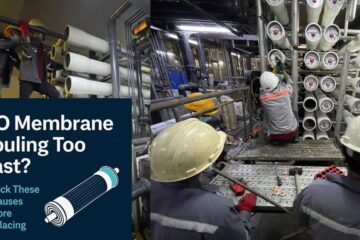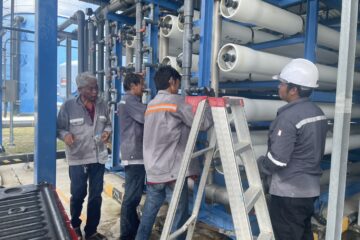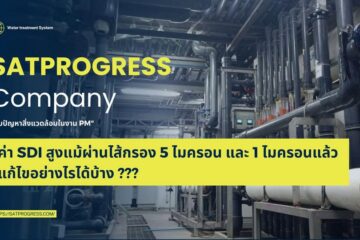In the water treatment industry, membrane fouling is a common issue that can significantly reduce the performance of Reverse Osmosis (RO) systems. To address this, industry professionals rely on a set of specialized cleaning techniques and preventive measures.
1. CIP (Clean-in-Place) Procedure
- Why It’s Important: CIP is a standard practice in the water treatment industry. It involves circulating a cleaning solution through the membrane modules without removing them from the system. The type of fouling determines the cleaning chemicals used: acidic cleaners (like citric acid) for scaling, alkaline cleaners (like sodium hydroxide) for organic fouling, and biocides for microbial contamination.
- Best Practice: Ensure that CIP procedures are done regularly, as specified by the membrane manufacturer. A proper CIP can restore up to 90% of the membrane’s performance when done correctly.
2. Feedwater Pretreatment
- Why It’s Critical: High Total Dissolved Solids (TDS), fouling due to colloidal particles, and biofouling can lead to rapid membrane degradation. Common pretreatment techniques include multimedia filtration, activated carbon filtration, and the use of anti-scalants and coagulants. Pretreatment reduces the load on the membrane and minimizes fouling.
- Best Practice: Conduct regular water analysis to monitor feedwater quality. Use coagulation and flocculation to reduce turbidity and remove suspended solids before water enters the RO system.
3. Membrane Autopsy
- Why It’s Necessary: When fouling persists despite regular cleaning, a membrane autopsy might be required to identify the exact cause of performance loss. This involves removing the membrane, sectioning it, and analyzing the foulant layer using scanning electron microscopy (SEM) or energy-dispersive X-ray spectroscopy (EDS).
- Best Practice: Schedule a membrane autopsy when performance drops by more than 15% despite regular CIP, or when cleaning effectiveness declines.
4. Monitoring and Adjusting System Parameters
- Key Parameters: Permeate flux, salt rejection, and differential pressure are critical parameters to monitor. A drop in permeate flux or an increase in differential pressure across the membrane modules often indicates fouling. Maintaining proper cross-flow velocity and operating pressures can prevent excessive fouling.
- Best Practice: Utilize a SCADA (Supervisory Control and Data Acquisition) system to automate monitoring of key parameters. This allows real-time adjustments to operational settings and triggers alarms when performance deviates from set thresholds.
5. Membrane Replacement Schedule
- Why It’s Necessary: Membranes have a finite lifespan, typically ranging from 3 to 5 years, depending on the operating conditions and cleaning frequency. Delaying replacement can lead to system inefficiencies and increased energy costs.
- Best Practice: Implement a proactive replacement schedule based on performance data, rather than waiting for membranes to fail completely. Regular monitoring of normalized flux and salt rejection can help predict when a membrane is nearing the end of its useful life.
Conclusion
Dealing with fouled RO membranes requires a systematic approach that includes regular CIP procedures, effective pretreatment, and continuous monitoring of system performance. In cases of severe fouling, membrane autopsy and timely replacement are critical to maintaining operational efficiency. By applying these techniques, water treatment professionals can extend membrane life and optimize system performance.
RO Membrane ตันต้องทำอย่างไร : คู่มือเชิงเทคนิค
ในการบำบัดน้ำ การอุดตันของเมมเบรน RO (Reverse Osmosis) เป็นปัญหาที่พบบ่อย ซึ่งสามารถลดประสิทธิภาพของระบบได้อย่างมาก การแก้ไขปัญหานี้ต้องอาศัยเทคนิคการทำความสะอาดและการป้องกันเฉพาะทาง นี่คือแนวทางในการแก้ไขปัญหาเมมเบรน RO ตัน
1. การทำความสะอาดในระบบ (CIP – Clean-in-Place)
- เหตุผลที่สำคัญ: การทำ CIP เป็นวิธีมาตรฐานในการทำความสะอาดเมมเบรนในระบบบำบัดน้ำ โดยที่ไม่ต้องถอดเมมเบรนออกจากระบบ สารทำความสะอาดจะถูกเลือกตามชนิดของคราบที่เกิด เช่น สารเคมีที่เป็นกรดสำหรับขจัดคราบตะกรัน (Scaling) และสารเคมีที่เป็นด่างสำหรับขจัดคราบอินทรีย์ (Organic Fouling) หรือใช้ Biocide ในกรณีที่มีการเติบโตของจุลินทรีย์
- แนวปฏิบัติที่ดีที่สุด: ควรดำเนินการ CIP อย่างสม่ำเสมอตามคำแนะนำของผู้ผลิตเมมเบรน การทำ CIP อย่างถูกวิธีสามารถฟื้นฟูประสิทธิภาพเมมเบรนได้มากถึง 90% .
2. การปรับปรุงน้ำดิบก่อนเข้าสู่ระบบ (Feedwater Pretreatment)
- เหตุผลที่สำคัญ: น้ำดิบที่มีปริมาณของแข็งละลายสูง (TDS) หรือมีการปนเปื้อนด้วยคอลลอยด์และจุลินทรีย์ อาจทำให้เมมเบรนเสื่อมสภาพได้เร็ว วิธีการปรับปรุงน้ำดิบ เช่น การกรองหลายชั้น (Multimedia Filtration) การใช้สารเคมีป้องกันการเกิดตะกรัน (Antiscalants) และการใช้ Coagulants เพื่อลดการสะสมของตะกอน
- แนวปฏิบัติที่ดีที่สุด: ควรทำการวิเคราะห์คุณภาพน้ำดิบอย่างสม่ำเสมอ และปรับปรุงน้ำดิบก่อนเข้าสู่ระบบ RO เพื่อยืดอายุการใช้งานของเมมเบรน
3. การผ่าพิสูจน์เมมเบรน (Membrane Autopsy)
- เหตุผลที่จำเป็น: เมื่อเกิดการอุดตันอย่างรุนแรงที่ไม่สามารถแก้ไขได้ด้วยการทำ CIP การผ่าพิสูจน์เมมเบรนจะช่วยวิเคราะห์ปัญหาได้ โดยการตัดเมมเบรนออกมาและตรวจสอบชั้นคราบด้วยกล้องจุลทรรศน์อิเล็กตรอน (SEM) หรือใช้เทคนิคการวิเคราะห์ X-ray (EDS)
- แนวปฏิบัติที่ดีที่สุด: ควรทำการผ่าพิสูจน์เมมเบรนเมื่อประสิทธิภาพลดลงมากกว่า 15% และการทำ CIP ไม่สามารถแก้ปัญหาได้
4. การตรวจสอบและปรับแต่งค่าพารามิเตอร์ของระบบ
- ค่าพารามิเตอร์ที่สำคัญ: ค่าการไหลของน้ำบริสุทธิ์ (Permeate Flux) การกักเกลือ (Salt Rejection) และความดันต่าง (Differential Pressure) เป็นค่าที่ต้องตรวจสอบ การลดลงของ Permeate Flux หรือการเพิ่มขึ้นของ Differential Pressure มักบ่งบอกถึงการเกิด Fouling ควรรักษาความเร็วในการไหลแบบ Cross-Flow และความดันที่เหมาะสมเพื่อลดการเกิดคราบ
- แนวปฏิบัติที่ดีที่สุด: ใช้ระบบ SCADA (Supervisory Control and Data Acquisition) เพื่อช่วยตรวจสอบค่าพารามิเตอร์สำคัญแบบเรียลไทม์ และตั้งค่าการแจ้งเตือนเมื่อระบบทำงานไม่ตรงตามค่าที่กำหนด
5. การเปลี่ยนเมมเบรนตามกำหนด
- เหตุผลที่จำเป็น: เมมเบรนมีอายุการใช้งานที่จำกัด โดยปกติจะอยู่ที่ 3-5 ปี ขึ้นอยู่กับสภาพการใช้งานและความถี่ในการทำความสะอาด การไม่เปลี่ยนเมมเบรนเมื่อถึงเวลากำหนดอาจทำให้ประสิทธิภาพของระบบลดลงและค่าใช้จ่ายในการดำเนินงานเพิ่มขึ้น
- แนวปฏิบัติที่ดีที่สุด: ควรมีแผนการเปลี่ยนเมมเบรนที่ชัดเจน โดยอิงตามข้อมูลการทำงานของระบบ ไม่ควรรอจนกว่าเมมเบรนจะเสื่อมสภาพจนไม่สามารถทำงานได้
สรุป
การแก้ปัญหาเมมเบรน RO ตันจำเป็นต้องใช้วิธีการที่เป็นระบบ รวมถึงการทำ CIP อย่างสม่ำเสมอ การปรับปรุงน้ำดิบ และการตรวจสอบค่าพารามิเตอร์ของระบบ หากการอุดตันยังคงเกิดขึ้น ควรดำเนินการผ่าพิสูจน์เมมเบรน และหากจำเป็นควรเปลี่ยนเมมเบรนเพื่อรักษาประสิทธิภาพของระบบ



0 Comments